| History of Ghana |
|---|
| |
| Timeline |
|
| By topic |
Economic history of Ghana details the economic situation of Ghana since pre-colonial times to date.
Contents
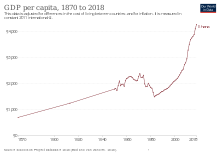
| History of Ghana |
|---|
| |
| Timeline |
|
| By topic |
Economic history of Ghana details the economic situation of Ghana since pre-colonial times to date.

Endowed with gold and oil palms and situated between the trans-Saharan trade routes and the African coastline visited by successive European traders, the area known today as Ghana has been involved in all phases of Africa's economic development during the last thousand years. [1] As the economic fortunes of African societies have waxed and waned, so, too, have Ghana's, leaving that country in the early 1990s in a state of arrested development, unable to make the "leap" to Africa's next, as yet uncertain, phase of economic evolution. [1]
As early as the thirteenth century, present-day Ghana was drawn into long-distance trade, in large part because of its gold reserves. [1] The trans-Saharan trade, one of the most wide-ranging trading networks of pre-modern times, involved an exchange of European, North African, and Saharan commodities for the products of the African savannas and forests, including gold, kola nuts, and slaves. [1] Present-day Ghana, named the Gold Coast by European traders, was an important source of the gold traded across the Sahara. [1] Centralized states such as Asante controlled prices by regulating production and marketing of this precious commodity. [1] As European navigational techniques improved in the fifteenth century, Portuguese and later Dutch and English traders tried to circumvent the Saharan trade by sailing directly to its southernmost source on the West African coast. [1] In 1482 the Portuguese built a fortified trading post at Elmina and began purchasing gold, ivory, and pepper from African coastal merchants. [1]
Although Africans for centuries had exported their raw materials — ivory, gold, kola nuts — in exchange for imports ranging from salt to foreign metals, the introduction of the Atlantic slave trade in the early sixteenth century changed the nature of African export production in fundamental ways. [1] An increasing number of Ghanaians sought to enrich themselves by capturing fellow Africans in warfare and selling them to slave dealers from North America and South America. [1] The slaves were transported to the coast and sold through African merchants, using the same routes and connections through which gold and ivory had formerly flowed. [1] In return, Africans often received guns as payment, which could be used to capture more slaves and, more importantly, to gain and preserve political power. [1]
An estimated ten million Africans, at least half a million from the Gold Coast, left the continent in this manner. [1] Some economists have argued that the slave trade increased African economic resources and therefore did not necessarily impede development, but others, notably historian Walter Rodney, have argued that by removing the continent's most valuable resource — humans — the slave trade robbed Africa of unknown invention, innovation, and production. [1] Rodney further argues that the slave trade fueled a process of underdevelopment, whereby African societies came to rely on the export of resources crucial to their own economic growth, thereby precluding local development of those resources. [1] Although some scholars maintain that the subsequent economic history of this region supports Rodney's interpretation, no consensus exists on this point. [1] Indeed, in recent years, some historians not only have rejected Rodney's interpretation but also have advanced the notion that it is the Africans themselves rather than an array of external forces that are to blame for the continent's economic plight. [1]
When the slave trade ended in the early years of the nineteenth century, the local economy became the focus of the so-called legitimate trade, which the emerging industrial powers of Europe encouraged as a source of materials and markets to aid their own production and sales. [1] The British, in particular, gained increasing control over the region throughout the nineteenth century and promoted the production of palm oil and timber as well as the continuation of gold production. [1] In return, Africans were inundated with imports of consumer goods that, unlike the luxuries or locally unavailable imports of the trans-Saharan trade, quickly displaced African products, especially textiles. [1]
In 1878 cacao trees were introduced from the Americas. [1] Cocoa quickly became the colony's major export; Ghana produced more than half the global yield by the 1920s. [1] African farmers used kinship networks like business corporations to spread cocoa cultivation throughout large areas of southern Ghana. [1] Legitimate trade restored the overall productivity of Ghana's economy; however, the influx of European goods began to displace indigenous industries, and farmers focused more on cash crops than on essential food crops for local consumption. [1]
When Ghana gained its independence from Britain in 1957, the economy appeared stable and prosperous. [1] Ghana was the world's leading producer of cocoa, boasted a well-developed infrastructure to service trade, and enjoyed a relatively advanced education system. [1] At independence, President Kwame Nkrumah sought to use the apparent stability of the Ghanaian economy as a springboard for economic diversification and expansion. [1] He began the process of moving Ghana from a primarily agricultural economy to a mixed agricultural-industrial one. [1] Using cocoa revenues as security, Nkrumah took out loans to establish industries that would produce import substitutes as well as process many of Ghana's exports. [1] Nkrumah's plans were ambitious and grounded in the desire to reduce Ghana's vulnerability to world trade. [1] Unfortunately, the price of cocoa collapsed in the mid-1960s, destroying the fundamental stability of the economy and making it nearly impossible for Nkrumah to continue his plans. [1] Pervasive corruption exacerbated these problems. [1] In 1966 a group of military officers overthrew Nkrumah and inherited a nearly bankrupt country. [1]
Since 1966 Ghana has been caught in a cycle of debt, weak commodity demand, and currency overvaluation, which has resulted in the decay of productive capacities and a crippling foreign debt. [1] Once the price of cocoa fell in the mid-1960s, Ghana obtained less of the foreign currency necessary to repay loans, the value of which jumped almost ten times between 1960 and 1966. [1] Some economists recommended that Ghana devalue its currency, the cedi, to make its cocoa price more attractive on the world market, but devaluation would also have rendered loan repayment in United States dollars much more difficult. [1] Moreover, such a devaluation would have increased the costs of imports, both for consumers and nascent industries. [1]
Until the early 1980s, successive governments refused to devalue the currency (with the exception of the government of Kofi Abrefa Busia, which devalued the cedi in 1971 and was promptly overthrown). [1] Cocoa prices languished, discouraging cocoa production altogether and leading to smuggling of existing cocoa crops to neighboring countries, where francs rather than cedis could be obtained in payment. [1] As production and official exports collapsed, revenue necessary for the survival of the economy was obtained through the procurement of further loans, thereby intensifying a self-destructive cycle driven by debt and reliance on vulnerable world commodity markets. [1]
By the early 1980s, Ghana's economy was in an advanced state of collapse. [1] Per capita gross domestic product (GDP) showed negative growth throughout the 1960s and fell by 3.2 percent per year from 1970 to 1981. [1] Most important was the decline in cocoa production, which fell by half between the mid-1960s and the late 1970s, drastically reducing Ghana's share of the world market from about one-third in the early 1970s to only one-eighth in 1982-83. [1] At the same time, mineral production fell by 32 percent; gold production declined by 47 percent, diamonds by 67 percent, manganese by 43 percent, and bauxite by 46 percent. [1] Inflation averaged more than 50 percent a year between 1976 and 1981, hitting 116.5 percent in 1981. [1] Real minimum wages dropped from an index of 75 in 1975 to one of 15.4 in 1981. [1] Tax revenue fell from 17 percent of GDP in 1973 to only 5 percent in 1983, and actual imports by volume in 1982 were only 43 percent of average 1975-76 levels. [1] Productivity, the standard of living, and the government's resources had plummeted dramatically. [1]
In 1981 a military government under the leadership of Flight Lieutenant Jerry John Rawlings came to power. Calling itself the Provisional National Defence Council (PNDC), the Rawlings regime initially blamed the nation's economic problems on the corruption of previous governments. Rawlings soon discovered, however, that Ghana's problems were the result of forces more complicated than economic abuse. [1] Following a severe drought in 1983, the government accepted stringent International Monetary Fund (IMF) and World Bank loan conditions and instituted the Economic Recovery Program (ERP). [1]
Signaling a dramatic shift in policies, the ERP fundamentally changed the government's social, political, and economic orientation. [1] Aimed primarily at enabling Ghana to repay its foreign debts, the ERP exemplified the structural adjustment policies formulated by international banking and donor institutions in the 1980s. [1] The program emphasized the promotion of the export sector and an enforced fiscal stringency, which together aimed to eradicate budget deficits. The PNDC followed the ERP faithfully and gained the support of the international financial community. [1] The effects of the ERP on the domestic economy, however, led to a lowered standard of living for most Ghanaians. [1]
In the early 1990s, Ghana's economic recovery still appeared uneven and was geared primarily to the export rather than domestic market. [1] GDP had risen by an average of 5 percent per year since 1984, inflation had been reduced to about 20 percent, and export earnings had reached US$1 billion. [1] Most production came from the export sector, and by the 1992-93 crop year, cocoa production surpassed 300,000 tons, placing Ghana third in the world. [1] In 1990 exports of minerals — primarily gold but also diamonds, manganese, and bauxite — brought in US$234 million, an increase of 23.2 percent from the year before. [1] Nevertheless, salaries were low, and because the cost of public services continued to rise, Ghana's poor bore the brunt of the negative effects of the austerity program. [1]
Oil was discovered in commercial quantities under the Presidency of John Kufuor. His successor, John Atta Mills initiated Ghana's first ever foray into oil production. [2] In 2010, the government rebased the economic statistics of the country resulting in an upward push of the GDP of Ghana by more than 60%. The base year for calculations was also changed from 1993 to 2006. The rebase moved Ghana into middle income status and it placed the country as the third largest in the ranking of GDP per person in West Africa behind Cape Verde and Nigeria. After the changes in statistics, the service sector became the largest sector of Ghana's economy with a share of 51%. Agriculture, which was initially the dominant sector, accounted for 30.2% after the economic rebasing whiles the industrial sector lagged behind with a share of 18.6%. [3] Ghana became the fastest growing nation in the world in 2011 [4] [5] [6] and once more in 2019. [7] [8] [9] Ghana’s rapid growth (7 percent per year in 2017-19) was halted by the consequences of COVID-19 pandemic, especially the March 2020 Ghana’s lockdown. [10]

The economy of Benin remains underdeveloped and dependent on subsistence agriculture and cotton. Cotton accounts for 40% of Benin's GDP and roughly 80% of official export receipts. There is also production of textiles, palm products, and cocoa beans. Maize (corn), beans, rice, peanuts, cashews, pineapples, cassava, yams, and other various tubers are grown for local subsistence. Benin began producing a modest quantity of offshore oil in October 1982. Production ceased in recent years but exploration of new sites is ongoing.

The economy of Cameroon was one of the most prosperous in Africa for a quarter of a century after independence. The drop in commodity prices for its principal exports – petroleum, cocoa, coffee, and cotton – in the mid-1980s, combined with an overvalued currency and economic mismanagement, led to a decade-long recession. Real per capita GDP fell by more than 60% from 1986 to 1994. The current account and fiscal deficits widened, and foreign debt grew. Yet because of its oil reserves and favorable agricultural conditions, Cameroon still has one of the best-endowed primary commodity economies in sub-Saharan Africa.

The economy of the Dominican Republic is the seventh largest in Latin America, and is the largest in the Caribbean and Central American region. The Dominican Republic is an upper-middle income developing country with important sectors including mining, tourism, manufacturing, energy, real estate, infrastructure, telecommunications and agriculture. The Dominican Republic is on track to achieve its goal of becoming a high-income country by 2030, and is expected to grow 79% in this decade. The country is the site of the single largest gold mine in Latin America, the Pueblo Viejo mine.Although the service sector is currently the leading employer of Dominicans, agriculture remains an important sector in terms of the domestic market and is in second place in terms of export earnings. Tourism accounts for more than $7.4 billion in annual earnings in 2019. Free-trade zone earnings and tourism are the fastest-growing export sectors. A leading growth engine in the Free-trade zone sector is the production of medical equipment for export having a value-added per employee of $20,000 USD, total revenue of $1.5 billion USD, and a growth rate of 7.7% in 2019. The medical instrument export sector represents one of the highest-value added sectors of the country's economy, a true growth engine for the country's emerging market. Remittances are an important sector of the economy, contributing $8.2 billion in 2020. Most of these funds are used to cover household expenses, such as housing, food, clothing, health care and education. Secondarily, remittances have financed businesses and productive activities. Thirdly, this combined effect has induced investment by the private sector and helps fund the public sector through its value-added tax. The combined import market including the free-trade-zones amounts to a market of $20 billion a year in 2019. The combined export sector had revenues totaling $11 billion in 2019. The consumer market is equivalent to $61 billion in 2019. An important indicator is the average commercial loan interest rate, which directs short-term investment and stimulates long-term investment in the economy. It is currently 8.30%, as of June 2021.

The economy of Ghana has a diverse and rich resource base, including the manufacturing and exportation of digital technology goods, automotive and ship construction and exportation, and the exportation of diverse and rich resources such as hydrocarbons and industrial minerals. These have given Ghana one of the highest GDP per capita in West Africa. Owing to a GDP rebasement, in 2011 Ghana became the fastest-growing economy in the world.

The economy of Grenada is a largely tourism-based, small and open economy. Over the past two decades, the main thrust of Grenada's economy has shifted from agriculture to services, with tourism serving as the leading foreign currency earning sector. The country's principal export crops are the spices nutmeg and mace. Other crops for export include cocoa, citrus fruits, bananas, cloves, and cinnamon. Manufacturing industries in Grenada operate mostly on a small scale, including production of beverages and other foodstuffs, textiles, and the assembly of electronic components for export.

The economy of Mali is based to a large extent upon agriculture, with a mostly rural population engaged in subsistence agriculture.

The economy of Nicaragua is focused primarily on the agricultural sector. Nicaragua itself is the least developed country in Central America, and the second poorest in the Americas by nominal GDP. In recent years, under the administrations of Daniel Ortega, the Nicaraguan economy has expanded somewhat, following the Great Recession, when the country's economy actually contracted by 1.5%, due to decreased export demand in the American and Central American markets, lower commodity prices for key agricultural exports, and low remittance growth. The economy saw 4.5% growth in 2010 thanks to a recovery in export demand and growth in its tourism industry. Nicaragua's economy continues to post growth, with preliminary indicators showing the Nicaraguan economy growing an additional 5% in 2011. Consumer Price inflation have also curtailed since 2008, when Nicaragua's inflation rate hovered at 19.82%. In 2009 and 2010, the country posted lower inflation rates, 3.68% and 5.45%, respectively. Remittances are a major source of income, equivalent to 15% of the country's GDP, which originate primarily from Costa Rica, the United States, and European Union member states. Approximately one million Nicaraguans contribute to the remittance sector of the economy.
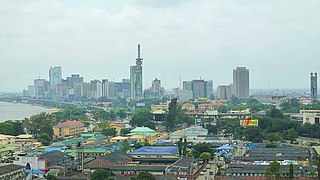
The Economy of Nigeria is a middle-income, mixed economy and emerging market with expanding manufacturing, financial, service, communications, technology, and entertainment sectors. It is ranked as the 31st-largest economy in the world in terms of nominal GDP, the largest in Africa and the 27th-largest in terms of purchasing power parity.

The economy of Seychelles is based on fishing, tourism, processing of coconuts and vanilla, coir rope, boat building, printing, furniture and beverages. Agricultural products include cinnamon, sweet potatoes, cassava (tapioca), bananas, poultry and tuna.
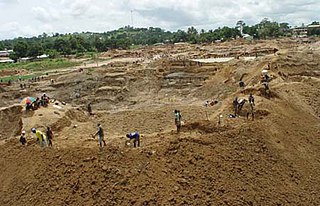
The economy of Sierra Leone is $4.082 billion by gross domestic product as of 2018. Since the end of the Sierra Leone Civil War in 2002, the economy is gradually recovering with a gross domestic product growth rate between 4 and 7%. In 2008 it in PPP ranked between 147th by World Bank, and 153rd by CIA, largest in the world.

The economy of Tanzania is a lower-middle income economy that is overwhelmingly dependent on agriculture. Tanzania's economy has been transitioning from a command economy to a market economy since 1985. Although total GDP has increased since these reforms began, GDP per capita dropped sharply at first, and only exceeded the pre-transition figure in around 2007.
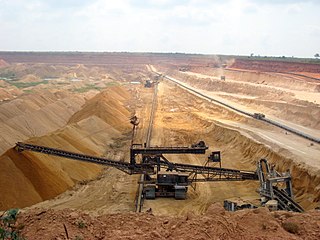
The economy of Togo has struggled greatly. The International Monetary Fund (IMF) ranks it as the tenth poorest country in the world, with development undercut by political instability, lowered commodity prices, and external debts. While industry and services play a role, the economy is dependent on subsistence agriculture, with industrialization and regional banking suffering major setbacks.

The economy of Guyana is one of the fastest growing in the world with a gross domestic product (GDP) growth of 19.9% in 2021. In 2022, Guyana had a per capita gross domestic product of $42,647 and an average GDP growth of 4.2% over the previous decade. Guyana's economy was transformed in 2015 with the discovery of an offshore oil field in the country’s waters about 120 miles from Georgetown. Crude oil production started in 2019.

The economy of São Tomé and Príncipe, while traditionally dependent on cocoa, is experiencing considerable changes due to investment in the development of its oil industry in the oil-rich waters of the Gulf of Guinea.

The economy of Africa consists of the trade, industry, agriculture, and human resources of the continent. As of 2019, approximately 1.3 billion people were living in 54 countries in Africa. Africa is a resource-rich continent. Recent growth has been due to growth in sales in commodities, services, and manufacturing. West Africa, East Africa, Central Africa and Southern Africa in particular, are expected to reach a combined GDP of $29 trillion by 2050.

Agriculture in Ghana consists of a variety of agricultural products and is an established economic sector, providing employment on a formal and informal basis. It is represented by the Ministry of Food and Agriculture. Ghana produces a variety of crops in various climatic zones which range from dry savanna to wet forest which run in east–west bands across Ghana. Agricultural crops, including yams, grains, cocoa, oil palms, kola nuts, and timber, form the base of agriculture in Ghana's economy. In 2013 agriculture employed 53.6% of the total labor force in Ghana.
Industry in Ghana accounts for about 24.5% of total GDP. However, Ghana's industrial production is rising at a 7.8% rate, giving it the 38th fastest growing industrial production in the world due to government industrialization policies.
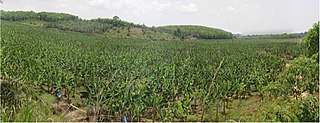
Agriculture was the foundation of the economy in Ivory Coast and its main source of growth. In 1987 the agricultural sector contributed 35 percent of the country's GDP and 66 percent of its export revenues, provided employment for about two-thirds of the national work force, and generated substantial revenues despite the drop in coffee and cocoa prices. From 1965 to 1980, agricultural GDP grew by an average 4.6 percent per year. Growth of agricultural GDP from coffee, cocoa, and timber production, which totaled nearly 50 percent of Ivory Coast's export revenues, averaged 7 percent a year from 1965 to 1980.

The economy of Ivory Coast is stable and currently growing, in the aftermath of political instability in recent decades. The Ivory Coast's economy is largely market-based and depends heavily on the agricultural sector. Almost 70% of the Ivorian people are engaged in some form of agricultural activity. GDP per capita grew 82% in the 1960s, reaching a peak growth of 360% in the 1970s, but this proved unsustainable and it shrank by 28% in the 1980s and a further 22% in the 1990s. This decline, coupled with high population growth, resulted in a steady fall in living standards. The Gross national product per capita, now rising again, was about US$727 in 1996. It was substantially higher two decades before.
{{cite encyclopedia}}: CS1 maint: postscript (link)